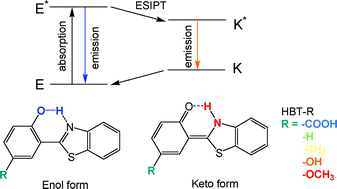Excited-state intramolecular proton transfer on 2-(2′-hydroxy-4′-R-phenyl)benzothiazolenanoparticles and fluorescence wavelength depending on substituent and temperature†
Abstract
The fluorescence emission properties of

* Corresponding authors
a
BT Convergence Technology Research Department, ETRI, Daejeon, Korea
E-mail:
josephinkim@etri.re.kr
Tel: +82-42-860-3908
b Optical Material Institute, Shindae Specialities Co. Ltd., Daejeon, Korea
c
Department of Advanced Materials Chemistry, Korea University, Sejong Campus, Chungnam, Korea
E-mail:
dwcho@korea.ac.kr
Fax: +82-41-867-5396
Tel: +82- 41-860-1796
The fluorescence emission properties of

 Please wait while we load your content...
Something went wrong. Try again?
Please wait while we load your content...
Something went wrong. Try again?
Y. H. Kim, S. Roh, S. Jung, M. Chung, H. K. Kim and D. W. Cho, Photochem. Photobiol. Sci., 2010, 9, 722 DOI: 10.1039/B9PP00102F
To request permission to reproduce material from this article, please go to the Copyright Clearance Center request page.
If you are an author contributing to an RSC publication, you do not need to request permission provided correct acknowledgement is given.
If you are the author of this article, you do not need to request permission to reproduce figures and diagrams provided correct acknowledgement is given. If you want to reproduce the whole article in a third-party publication (excluding your thesis/dissertation for which permission is not required) please go to the Copyright Clearance Center request page.
Read more about how to correctly acknowledge RSC content.
 Fetching data from CrossRef.
Fetching data from CrossRef.
This may take some time to load.
Loading related content
